Hi-van is supported by its audience. When you purchase using our links, we may earn an affiliate commission (no added cost to you). Learn more
For the comfort of your RV, having the right thermostat can make all the difference. A thermostat keeps the temperature inside the vehicle consistent, regardless of the weather outside. But how do you choose the best RV thermostat?
To make choosing an RV thermostat easier, think about your budget, desired features, system compatibility, and ease of use.
To simplify the process, this article will guide you through selecting the best RV thermostat for your needs.
The Role of Thermostats in your RV
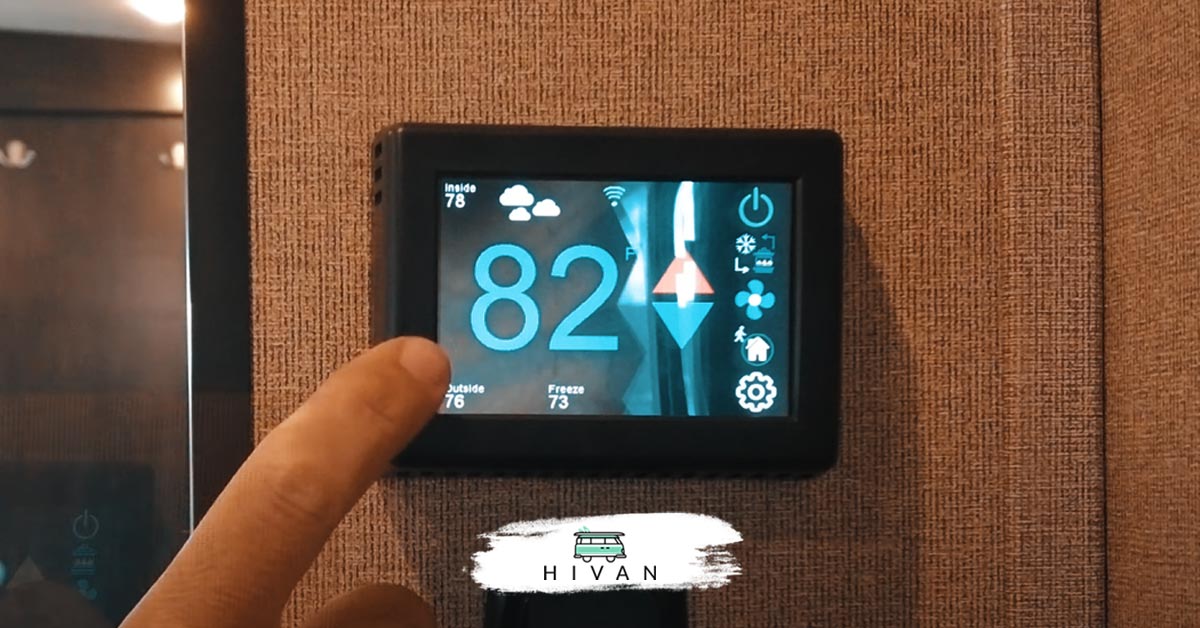
The RV thermostat regulates the indoor climate, keeping you snug or cool as needed. It’s the unsung hero that lets you enjoy a warm, toasty evening when the temperatures drop or keeps things refreshingly cool when the sun blazes down.
RV thermostats are not merely temperature controllers; they are the gatekeepers of comfort, offering you a sanctuary on wheels, where you can relax, unwind, and recharge after a day of exploration.
Why Upgrading Your RV Thermostat Matters?
Imagine the convenience of controlling your RV’s interior temperature while saving on energy costs. This is precisely why upgrading your RV thermostat matters.
In the upcoming chapters, we’ll explore RV thermostat types, features, and installation/maintenance steps.
This guide will help you make an informed decision that improves your comfort and saves money on RV adventures.
So, let’s embark on this exciting journey of RV thermostat exploration.
Types of RV Thermostats
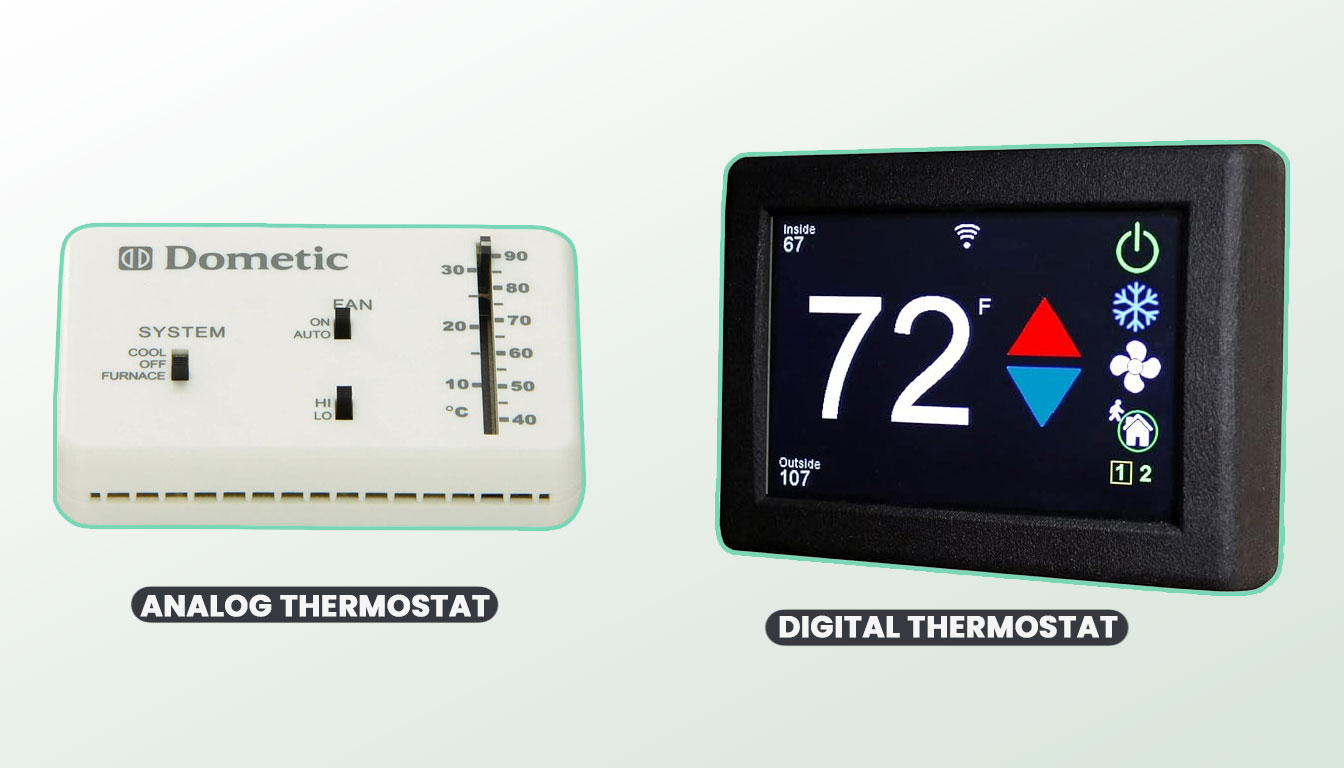
Analog vs. Digital Thermostats
RV thermostats come in two primary flavors: analog and digital.
Your choice between analog and digital will impact your comfort and control on the road.
Understanding the differences between these thermostat types will help you select the one that suits your needs.
Let’s explore the characteristics of analog and digital thermostats.
Analog Thermostats
Analog thermostats are the tried-and-true veterans of RV temperature control. They are simple, reliable, and user-friendly. With a mechanical dial, you can easily set your desired temperature. They are a popular choice among RVers who prefer straightforward operation.
![]() Pros
Pros
- Ease of Use: Analog thermostats are intuitive and require a minimal learning curve.
- Reliability: Mechanical components are less prone to electronic malfunctions.
- Affordability: They are often more budget-friendly compared to their digital counterparts.
![]() Cons
Cons
- Limited Features: Analog thermostats typically offer basic temperature control without advanced features.
- Less Precision: Fine-tuning temperature settings can be challenging.
Digital Thermostats
Digital thermostats bring modernity to your RV’s climate control. They come equipped with digital displays and offer precise temperature settings.
Digital thermostats can be programmed to change temperatures according to your schedule.
![]() Pros
Pros
- Precision: Digital thermostats provide accurate temperature control.
- Programmability: You can set schedules for temperature adjustments.
- Advanced Features: Some models offer additional features like Wi-Fi connectivity.
![]() Cons
Cons
- Complexity: Digital thermostats may have more intricate settings that require some learning.
- Higher Cost: They can be more expensive than analog thermostats.
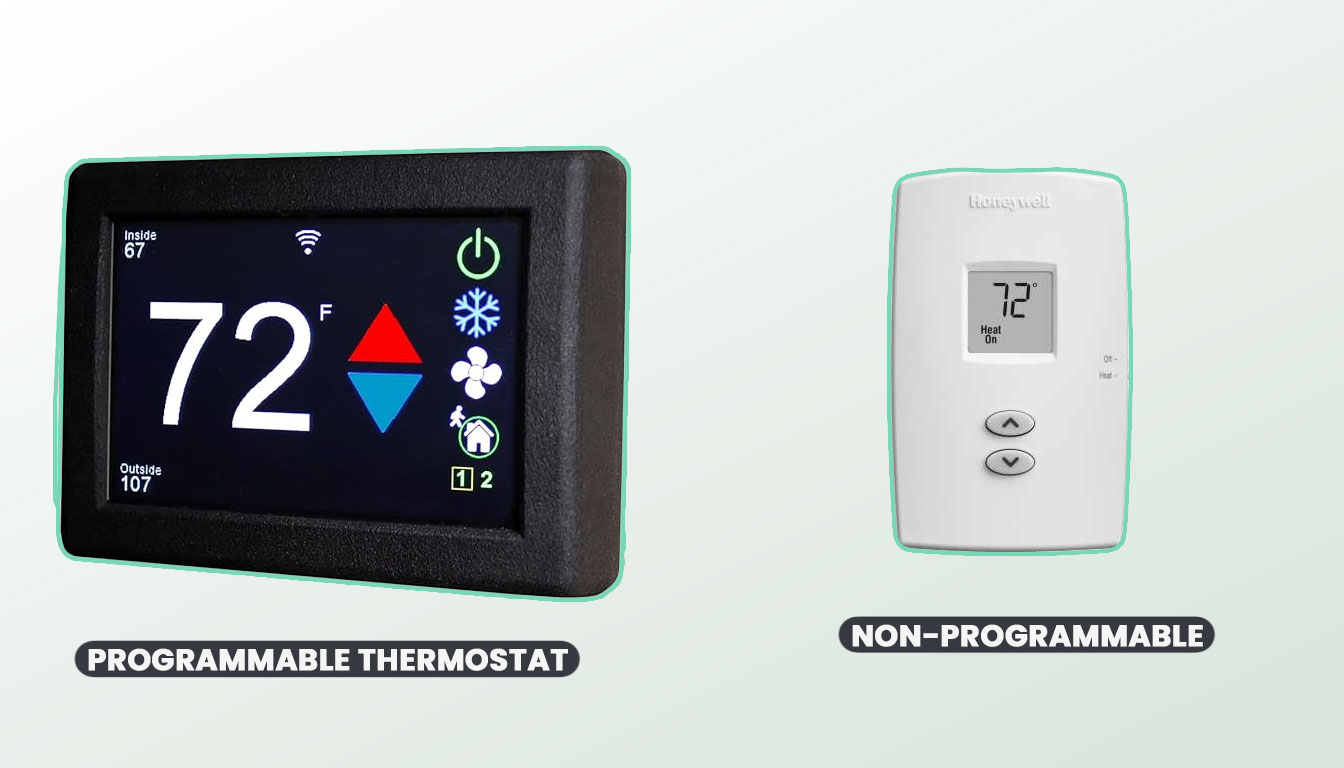
Programmable vs. Non-Programmable Thermostats
RV thermostats can be further classified into programmable and non-programmable variants.
Knowing the advantages and drawbacks of each will guide your selection and let you select the right thermostat.
Programmable Thermostats
Programmable thermostats enable you to create customized schedules for your RV’s heating and cooling. This feature is useful if you have regular routines or if you want to optimize energy consumption.
![]() Pros
Pros
- Energy Efficiency: Set temperature setbacks when you’re away to save on heating or cooling costs.
- Convenience: Enjoy automated temperature changes without manual adjustments.
- Comfort: Return to a pre-set comfortable temperature after being away from your RV.
![]() Cons
Cons
- Complex Setup: Initial programming may require some time and effort.
- Cost: Programmable thermostats can be pricier than non-programmable ones.
Non-Programmable Thermostats
Non-programmable thermostats offer straightforward temperature control without scheduling options. They are suitable if you prefer manual adjustments or if your RV usage patterns are less predictable.
![]() Pros
Pros
- Simplicity: Adjust the temperature manually without programming.
- Affordability: Non-programmable thermostats are often more budget-friendly.
![]() Cons
Cons
- Lack of Automation: You won’t benefit from automated temperature adjustments.
- Potential for Energy Waste: Forgetting to adjust the thermostat when leaving can lead to energy inefficiency.
As you move forward, consider how these choices align with your travel style and needs. The thermostat you select will be the key to creating your desired climate on the road.
RV Thermostat Compatibility
To get the best performance, you need to ensure your thermostat is compatible with your RV’s heating and cooling system.
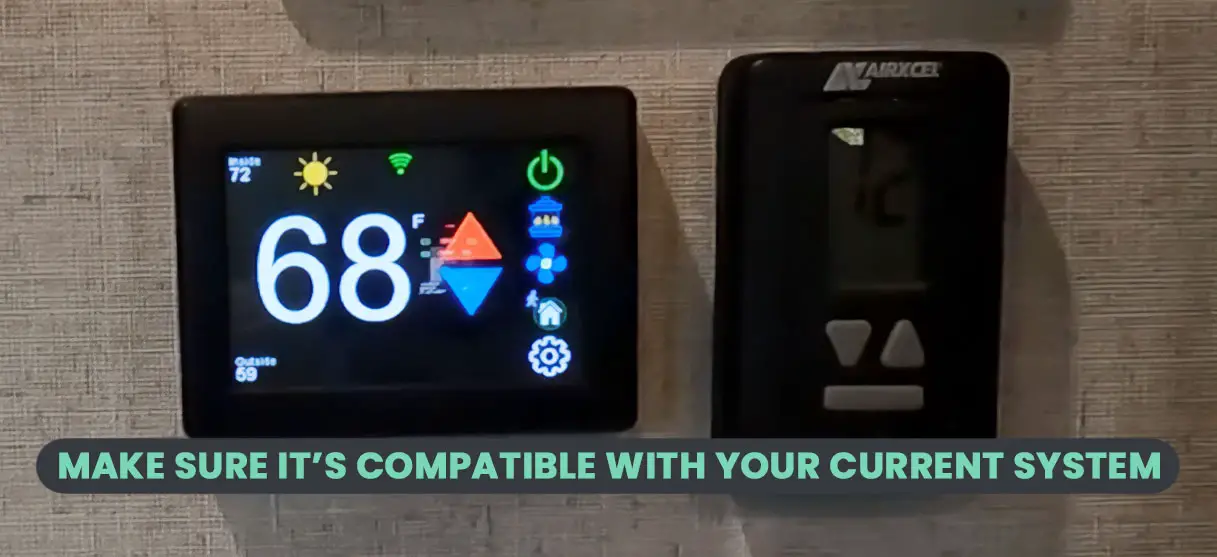
Here’s how to assess compatibility:
HVAC System Type
Identify which type of HVAC (Heating, Ventilation, and Air Conditioning) your RV uses.
Thermostats work differently for each system, such as electric, gas, or heat pump systems.
Wiring Compatibility
Some thermostats may require specific wiring configurations, so it’s essential to verify compatibility. For example, you can find battery powered or hard wired RV thermostats.
How many wire terminals does the thermostat have? Most modern RVs will require four wires for an installation: two power and two “common” or neutral wires to be shared by both heating and cooling equipment. Old models may vary slightly.
Do you need special programming for your thermostat? If so, remember that not all RVs will have the exact electronic system. Some older types of RV do not include a thermostat with a touch screen, and so it may require more power, more wires, and a new installation setup.
Zoning
If your RV has a multi-zone HVAC system, consider a thermostat that supports zoning. Zoning allows you to control different areas or zones of your RV independently, optimizing comfort and energy efficiency.
Remote Control and Connectivity
You might want a thermostat with remote control and connectivity options like Wi-Fi or bluetooth for added convenience. Smart thermostats can be controlled via smartphone apps, making it easy to adjust the temperature even when you’re away from your RV.
Read the product specifications and consult with experts if needed to choose the right thermostat for your RV’s unique needs.
Installation and Setup
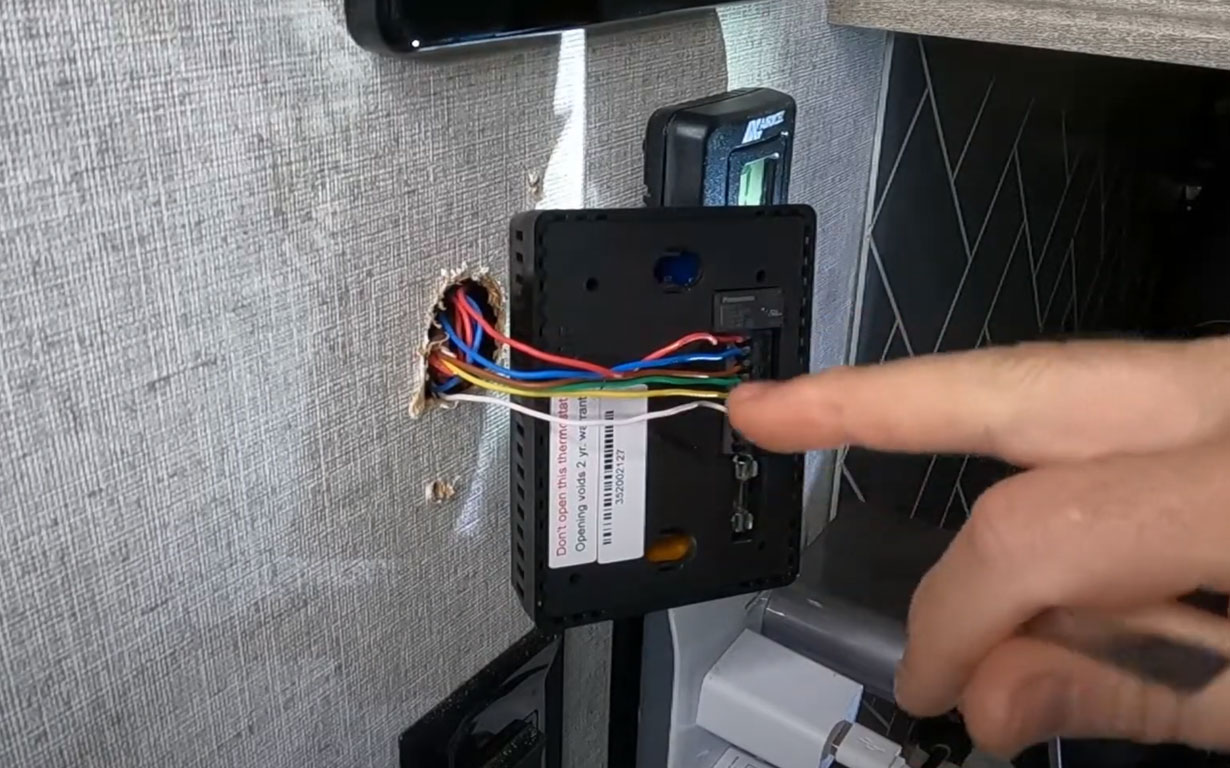
When it comes to upgrading your RV thermostat, the installation and setup phase is where the rubber meets the road. This is the stage where you’ll transform your comfort aspirations into tangible reality. In this chapter, we’ll navigate through the crucial steps of installing and setting up your new RV thermostat.
DIY vs. Professional Installation
You have two options: doing it yourself or hiring a professional. Here are the pros and cons of each:
DIY Installation
![]() Pros
Pros
– Cost Savings: Doing it yourself can save you money on installation fees.
– Learning Experience: It’s an opportunity to learn more about your RV’s systems.
– Flexibility: You can schedule the installation at your convenience.
![]() Cons
Cons
– Technical Skill Required: DIY installation requires a good understanding of RV electrical systems.
– Time-Consuming: It may take longer, especially if you’re new to RV thermostat installation.
– Risk of Errors: Incorrect wiring can damage your HVAC system or even pose safety hazards.
Professional Installation
![]() Pros
Pros
– Expertise: Professionals have the knowledge and experience to ensure a correct installation.
– Efficiency: They can complete the job quickly and accurately.
– Reduced Risk: Professional installation minimizes the chances of errors or safety concerns.
![]() Cons
Cons
– Cost: You’ll need to budget for installation fees.
– Scheduling: You’ll need to coordinate with the technician’s availability.
Common Installation Mistakes to Avoid
To ensure a smooth installation process, avoid these common mistakes:
- Incorrect Wiring: Cross-wiring or improper connections can lead to system malfunctions.
- Neglecting Safety: Always turn off power before starting and follow safety guidelines.
- Rushing the Job: Take your time to ensure each step is done correctly.
- Ignoring Instructions: Don’t skip reading the manufacturer’s installation manual.
Troubleshooting Common Issues
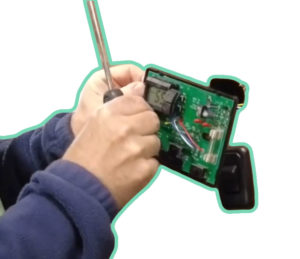
Even with proper maintenance, issues can occasionally arise with your RV thermostat.
Let’s explore some common problems and their solutions.
Thermostat Not Responding
Solution: Check the power source and ensure there are no blown fuses or tripped breakers. If the thermostat still doesn’t respond, it may require a professional diagnosis.
Inaccurate Temperature Readings
Solution: Recalibrate your thermostat following the manufacturer’s instructions. If the issue persists, contact a technician for further assessment.
HVAC System Doesn’t Start
Solution: Ensure that the thermostat is set to the desired temperature and mode. Check for power supply issues or blown fuses in your RV’s electrical system. If you can’t identify the problem, consult a professional.
Limited Control or Malfunctions
Solution: Perform a thorough cleaning of your thermostat and its components. If problems persist, consider reaching out to a technician for repairs.
Maintaining your RV thermostat is essential for comfort during your travels. To keep your thermostat working well, clean it regularly, calibrate it, and learn how to fix common problems.
Best RV Thermostats
We have compiled a list of the best RV thermostats to make your traveling experience more convenient.
Check out our top picks below.
🛠️ It is programmable, automatically detects system sources, and is compatible with major RV AC Thermostat Controls.
❄️ The thermostat is easy to replace with 30 different models to choose from, and no additional electronics are required.
Our Top Pick: MICRO-AIR EasyTouch Digital Thermostat
pros
- Large touch screen for quick adjustments
- Programmable with wireless capabilities
- Easy replacement
- Broad compatibility
![]() cons
cons
- More expensive
- Lack of detailed installation instructions
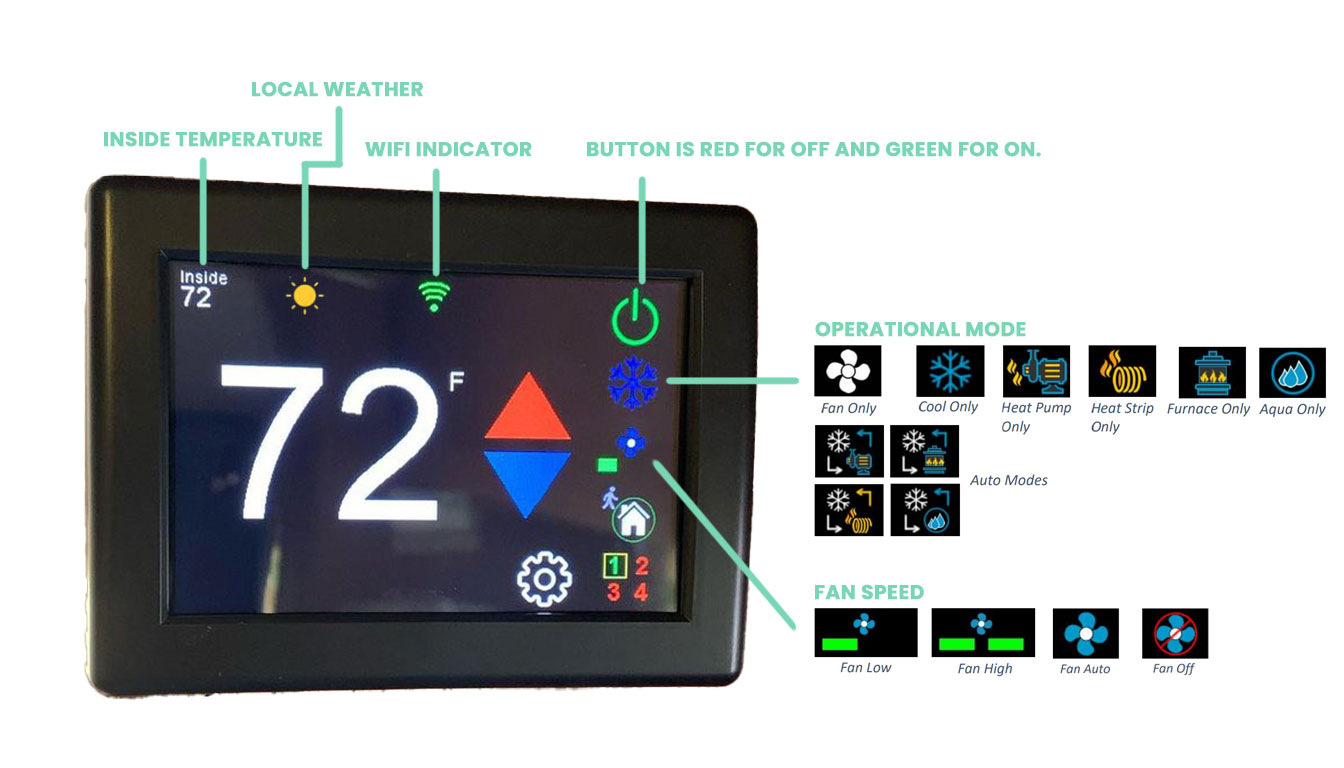
The MICRO-AIR Thermostat is the perfect addition to any RV setup, ensuring a comfortable and hassle-free environment. Its large color touch screen makes it easy to adjust temperatures in a timely manner, even in the dark. With its programmable and wireless features, it makes it easy to configure even if you’re away for a walk.
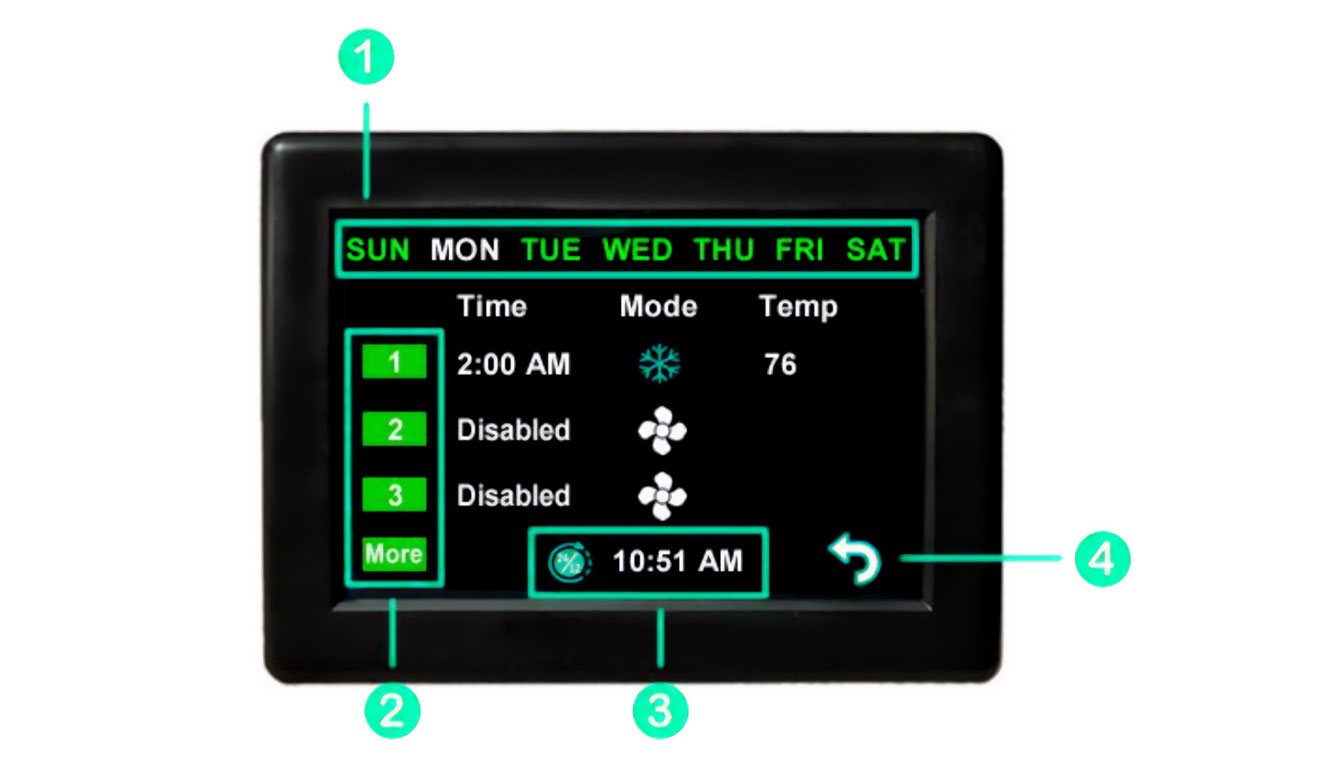
The schedule function allows you to schedule events for each day of the week. These events can include changes to the temperature or mode of operation for one or more zones.
1) Day of the Week
2) Scheduled Events
3) System Time
4) Back
The EasyTouch is a compact device that can automatically detect and control different system sources like furnaces, heat strips, and cooling, offering both versatility and efficiency.
We tested and installed the Micro-Air EasyTouch model 351 and it’s an excellent option for RV owners who want to upgrade their thermostat.
The installation process was straightforward and only took about 20 minutes, even for someone who’s not an expert in electrical systems.
The EasyTouch is incredibly user-friendly, with a sleek design and intuitive controls that make it a pleasure to use. It’s also highly accurate, with precise temperature control and a responsive interface.
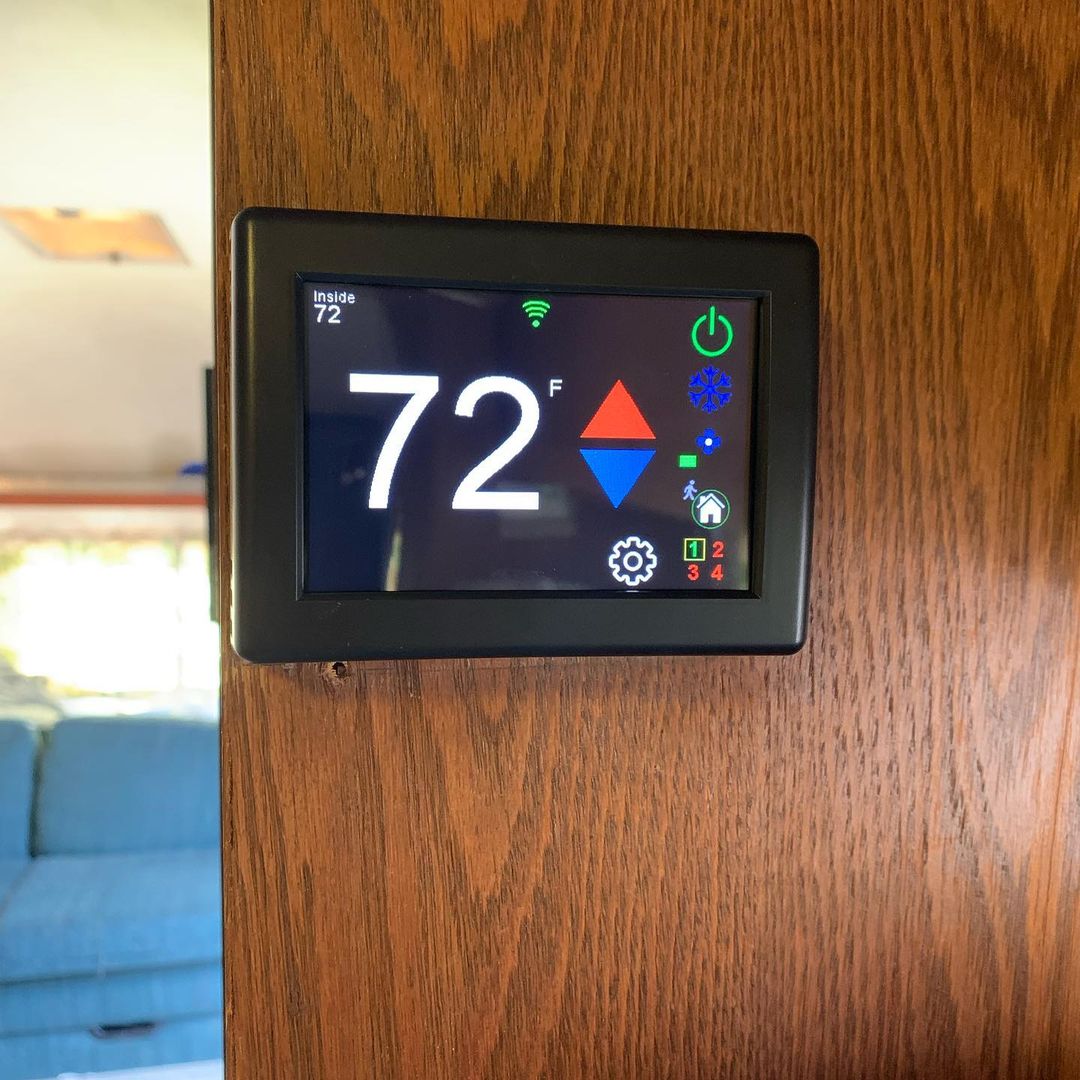
RV enthusiasts will find the MICRO-AIR Thermostat to be a valuable investment, despite the higher cost.
The EasyTouch thermostat is built to last, and its reliability and accuracy make it a worthwhile investment in the long run.
If you want to check a quick intro guide on how to install it, you can check this video on youtube by RV Tips & Travels
🌡️ Adjustable Temperature Scale: Standard Selection Of 40 To 90°F.
🔆 Backlit Display for easy reading.
🔋 Power source type: Battery Powered.
Most Affordable Honeywell Non-Programmable Thermostat
The Honeywell TH1100DV1000/U is a reliable thermostat for RV enthusiasts who want simplicity and ease of use.
pros
- Adjustable temperature scale from 40 to 90°F
- Clear, backlit display for easy reading
- Shows ambient temperature at all times
- Cheap
![]() cons
cons
- Non-programmable – no scheduling features
- Requires batteries for power
- No Celsius option for temperature display
We recently installed this Honeywell Thermostat in our RV and found it to be a reliable solution for controlling the temperature. The adjustable temperature scale, ranging from 40 to 90°F, gives us the flexibility to set the desired temperature according to our needs while on the road.
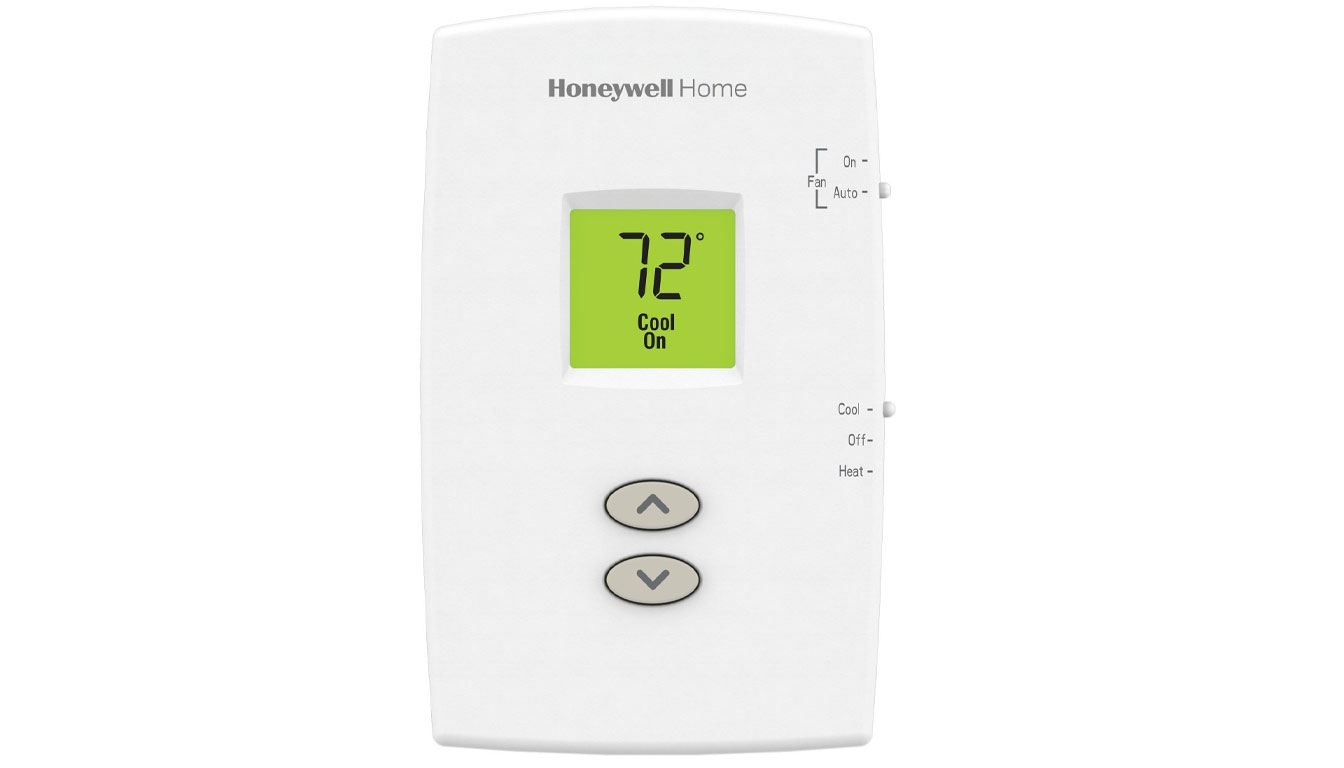
The backlit display on this Honeywell thermostat makes it easy to read, even in low light. We appreciate how it always displays the ambient temperature, so we have a constant understanding of the actual temperature in our RV.
This thermostat doesn’t have a programming feature, so we can’t schedule temperature changes. This may not be an issue for some RV owners, but those who would like more customization and scheduling options might find this limiting.
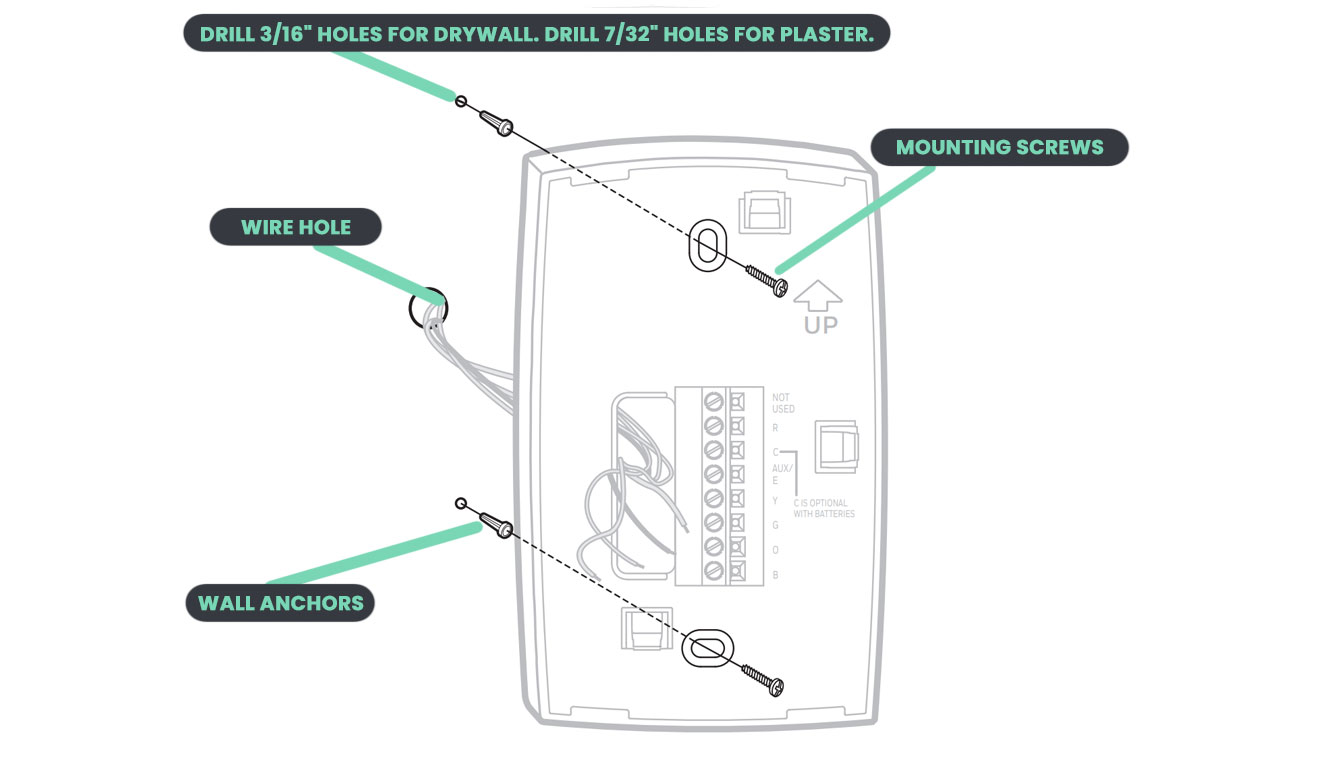
It requires batteries for power, so be prepared to replace them as needed. While changing batteries can be a hassle, it’s easier to set up and prevent draining your RV’s battery.
The absence of a Celsius option for temperature display in this model might inconvenience metric users.
If you want an easy-to-use and reliable thermostat for your RV adventures, the Honeywell TH1100DV1000 is a great choice.
🏷️ Non-programmable and designed for use in HVAC systems.
🛠️ Easy installation
✅ Accuracy, ease of use, and value for money.
Great for Coleman systems: Coleman Machine Thermostat
The Coleman Machine 94303382 Digital Hot/Cool Thermostat is an ideal choice for upgrading your RV’s temperature control system.
pros
- Easy to install
- Compatible with non-programmable systems
- Digital display
![]() cons
cons
- Not suitable for zone control
- A ground wire is required
- Can only replace Coleman thermostat
- Durability issue
The Coleman Machine Thermostat in our RV has made a big difference in our temperature control.
The digital display allows us to monitor and adjust the temperature easily. We would have appreciate if we could monitor the set temperature and air temperature simultaneously.
To install it, we had to drill new holes to mount the thermostat to our RV wall.
Furthermore, the wire connections at the back of the device are small and tricky to work with, so take your time and disconnect the power before installing.
The thermostat is easy to use and has accurate temperature control, but it’s unfortunately not compatible with zone-controlled systems.
Finally, here’s the perfect video to show you step by step how you can upgrade your Coleman thermostat.
FAQs
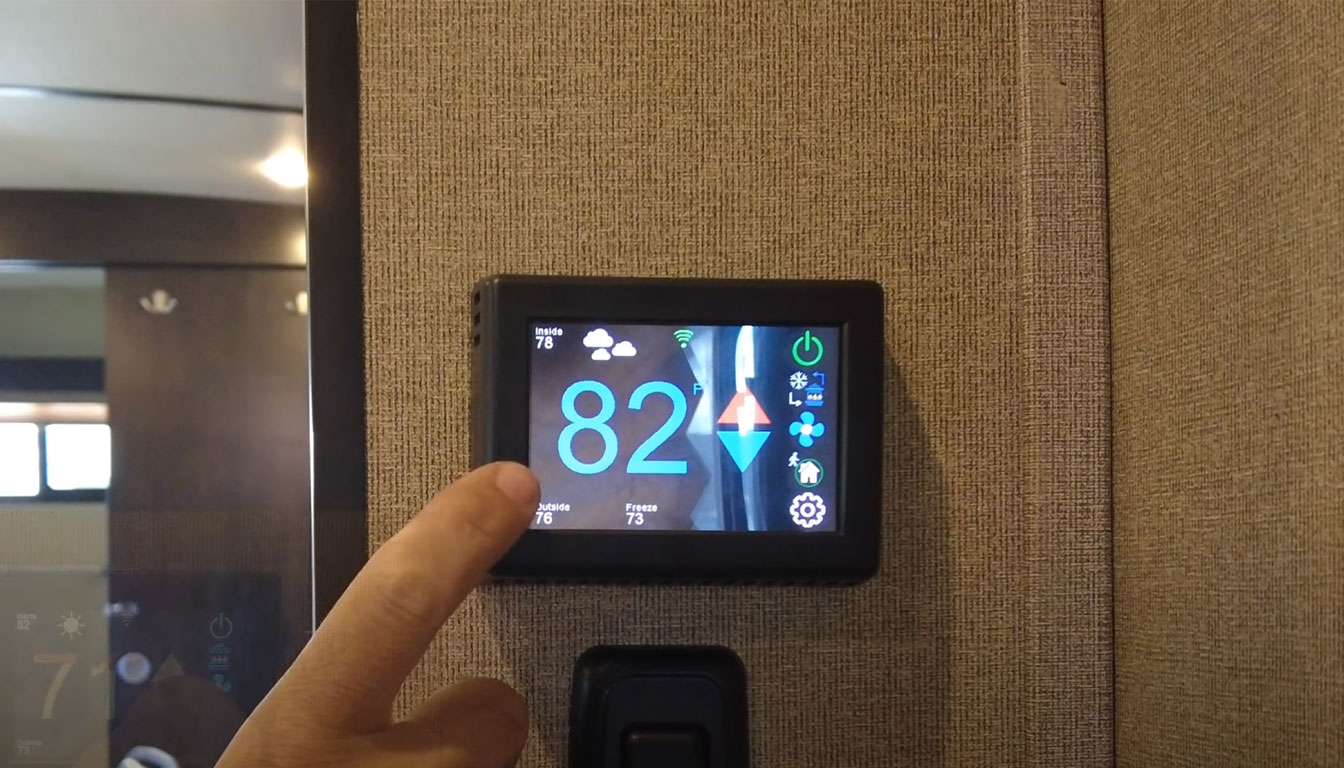
Can I replace my RV thermostat with any thermostat?
No, not all thermostats are compatible with RVs. Select a thermostat made for RVs to ensure it works correctly with your heating and cooling system.
Are smart thermostats compatible with all RVs?
Smart thermostats are not compatible with all RVs. Some RVs may require additional wiring or modifications for a smart thermostat to function correctly. Always consult your RV’s manual or a professional before installing a smart thermostat.
How do I know if my RV thermostat needs an upgrade?
If your RV thermostat is not accurately regulating temperature or if it’s outdated, it might be time for an upgrade. New thermostats are more precise and energy-efficient, making them a good investment.
What’s the difference between analog and digital thermostats?
Analog thermostats are cheaper but less accurate. Digital thermostats cost more but have better accuracy and added features such as Wi-Fi connectivity and scheduling.
Do programmable thermostats really save energy?
You can save energy with programmable thermostats by setting temperature schedules. This reduces energy consumption and lowers your cost.
Is it worth investing in a high-end RV thermostat?
A good RV thermostat provides better temperature control, saves energy, and has extra features like programming and remote access.
These benefits can make it worth investing in a high-quality thermostat, particularly for those who frequently use their RV.
Can I install an RV thermostat myself, or should I hire a professional?
If you’re not confident in electrical work or need modifications for your RV’s wiring, it’s best to hire a professional to install your RV thermostat.
How often should I calibrate my RV thermostat?
It’s a good idea to calibrate your RV thermostat at least once a year. Regular calibration ensures accurate temperature readings and optimal performance.
Are RV Thermostats the Same as Home Thermostats?
RV thermostats are less complex than home thermostats, as they have fewer components to regulate air temperature.
If you fall in love with a home thermostat when searching for an RV thermostat, do not fret. You can install a home thermostat in your RV, but you will need a professional to do the installation. This way, they can make sure the wiring is done properly, and the voltage is correct.
In Brief: Considerations for A New RV Thermostat
There are many kinds of thermostats on the market that cater to all budgets and preferences. After that, you need to look at if a replacement is truly needed and how to go about installing correctly. Once all these things are taken into consideration, you can make your decision and purchase the RV thermostat that is best suited for you.



